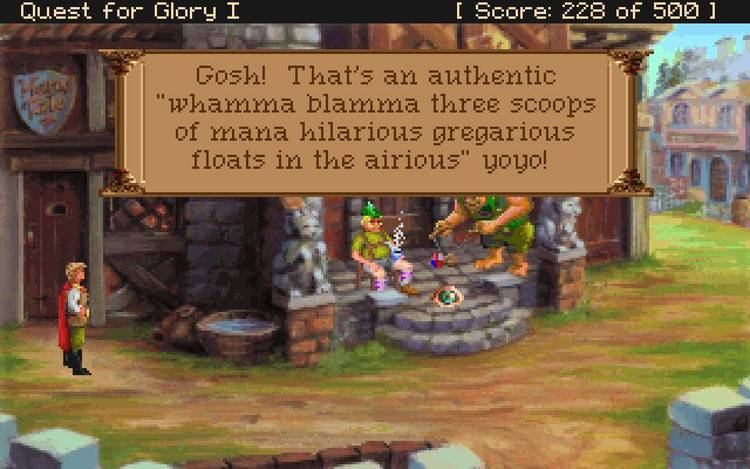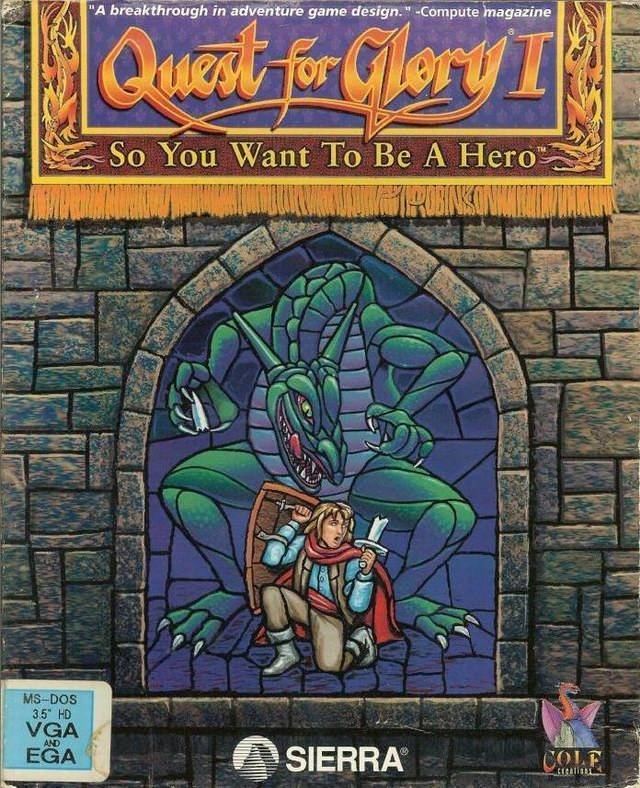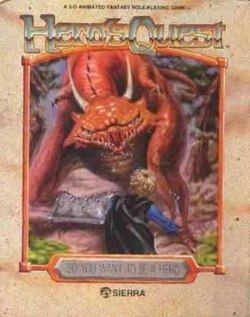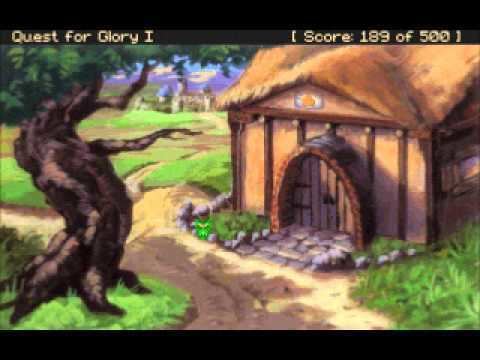9.4 /10 1 Votes9.4
Initial release date October 1989 Designer The Coles | 4.7/5 My Abandonware Mode(s) Single-player Developer Sierra Entertainment Publisher Sierra Entertainment | |||||||||||||||||||||||||||||||||
 | ||||||||||||||||||||||||||||||||||
Similar Quest for Glory games, Sierra Entertainment games, Adventure games | ||||||||||||||||||||||||||||||||||
Hero's Quest: So You Want to Be a Hero (later re-released as Quest for Glory: So You Want to Be a Hero because of trademark issues involving the HeroQuest board game) is an adventure game/role-playing game hybrid, designed by Lori Ann Cole and published by Sierra On-Line. It is the first game in the Quest for Glory series, and has been credited for being a genre-defining game, as it tried to mix graphical adventure gaming with role-playing-like elements such as statistic building (strength, intelligence, health) that would actually affect the ability to accomplish certain parts of the game. The game has a satirical and silly tone.
Contents

Gameplay
The original title was an adventure game with a text parser, with players typing commands for the character to perform, while the remake is a point-and-click adventure game.
The game advertised itself as "three games in one" since it was the first Sierra game that (according to RPG customs) allowed the selection of a character out of three classes: Fighter, Magic User, and Thief. What class the hero assigns to a character largely determines with what equipment the character begins, how they can solve puzzles and what quests they will run into. However, the distinction between classes was not an absolute one; players could add skills to a character and allow them to complete quests related to other classes in this game and others in the series.

Quest for Glory introduced a realism rarely found in RPGs and other adventure games even today. Day, night and the passage of time was a factor; the setting and scenery was different during day and night. The main character had to eat on a regular basis, he would become tired from running and fighting which required rest and sleep. Skills were not obtained by gaining levels through combat, but rather increased distinctly through the regular course of adventuring. The more the player used magic, the more the Hero's Magic ability would increase (followed by Intelligence); likewise the more the player engaged in battle, training, or even cleaning the baron's stables, the more the Hero's Strength, Vitality and Agility would increase.

This is one of the few Sierra adventure games where the player character has few or no speaking lines. Although the player can input commands such as "ask about brigands", the player character has almost no dialogue.
Plot
In the valley barony of Spielburg, the evil ogress Baba Yaga has cursed the land and the baron who tried to drive her off. His daughter has disappeared and his son has been transformed into a bear, while the land is ravaged by monsters and brigands. The Valley of Spielburg is in need of a Hero able to solve these problems. The player's character is a customized adventurer whose name and class is chosen by the player. The game follows the Hero, who is a recent graduate of the Famous Adventurer's Correspondence School, on his journey into the land. He must help people and become a proclaimed Hero.
The adventurer battles brigands and monsters such as kobolds, solves side quests (such as finding lost items and spell ingredients) and helps fantasy creatures such as a dryad, a hermit and a colourful collection of furry creatures called Meeps. Fulfilling quests will grant him experience and money, which he may use to buy equipment and potions. The game is open ended, which means the player can explore all the game at once and solve the quests in any order. During the quest, the character also meets recurring series characters such as the wizard Erasmus and his familiar Fenrus, and first hears tales of the benevolent faery Erana.
While the game can be completed without solving the secondary quests, in the optimal ending, which nets the player the maximum score and serves as canon for the remainder of the series, the player frees the baronet from a powerful curse and thwarts the plans of the witch Baba Yaga. Finally, the adventurer frees the baron's daughter, Elsa von Spielburg, from the curse which had transformed her into the brigand leader. By doing so, the adventurer fulfills a prophecy, restores Spielburg Valley to prosperity, and is awarded the title of Hero. After this, the Hero, along with the merchant Abdulla Doo and the innkeepers Shameen and Shema, leaves on a magic carpet for Shapeir, the homeland of the three, setting the plan for the sequel, Quest for Glory II: Trial by Fire.
Development
The idea for Quest for Glory was that the game should "be as much about story as it was about combat and exploration". The story and setting are culled from various fairytale sources.
Many planned features were cut off in the development progress, to release the game in a realistic amount of time. Originally, Lori had planned for four different races: thief-like gnome, magic wielding elf, human as jack of all trades, and archer centaur, as well as the option for a female player character. Due to the limited resources available, the development team scaled back these plans, compromising with multiple classes for the human character. In the original design, there was supposed to be a big goblin maze. References to this have remained in the goblin base of the original version. Many of the town buildings were planned to be enterable. Also, magic users were supposed to be able to get a familiar like Zara had, but it was cut due to programming difficulties.
The original game sported EGA graphics, while the remake had VGA graphics.
According to Corey Cole, one of the game's developers and producers, the original Quest for Glory game cost $150,000 to make, while the VGA remake cost almost as much to make as a full VGA entry.
Reception
So You Want to Be a Hero is credited as a genre-defining video game, due to its mix of adventure and roleplaying elements.
Computer Gaming World in 1990 stated that the game's puzzles were easy, but still fun for an experienced player, and that excellent graphics and good use of humor and role-playing elements made the game "a definite winner". In 1990 the magazine named it as Adventure Game of the Year, describing it as one of the few introductory games that both beginners and veterans of adventures enjoyed. In 1993 the magazine approved of the "cute hybrid"'s graphics, humor, and replyability.
Michael Baker of RPGamer scored the game 3.5 out of 5, writing that it is "a piece of RPGaming history that stands the test of time" that balances puzzles, gameplay, and writing to entertaining effect, while finding the game's pacing to be sometimes too slow. Tyler Willis of RPGamer gave the game 4 out of 5 stars, praising especially the personality and presentation of its in-game locations and characters. Richard Cobbett for PC Gamer stated that his impressions of the game are "almost all" positive, especially for the VGA remake, due to the great adventure offered and the spectacular game world.
According to Corey Cole, the game became one of Sierra's fastest-selling products, selling over 250,000 copies in its initial years.
Remake
Like the first games in the King's Quest, Space Quest, Police Quest, and Leisure Suit Larry series, a VGA version using Sierra's point and click SCI1.1 interpreter was released in 1992. This version had input limitations compared to the original, which used the text-parser–based SCI0. The VGA remake and original version were also released on CD-ROM as part of the 1996 Anthology collection and 1997 Collection Series.
While the original game was based on dialogues and asking questions in order to obtain some background information, in the new interface the dialogues had a tree structure: a menu of question topics. By asking certain questions (e.g., "Ask about Potion"), the player will get new questions to ask (e.g., "Healing potion", Stamina potion", "Dispel potion"). The backgrounds and characters were hand drawn and scanned, while the monster fights and character portraits were made using clay models and stop motion animation. Unlike other games, running out of stamina points here can kill the hero outright instead of starting to do health damage. Some easter eggs were also updated, for example in Erasmus's house, the original has a reference to King's Quest IV, while the remake has a reference to The Dagger of Amon Ra. The treasure room in the troll cave leading to the Brigand's hideout was missing in the remake.
According to Corey Cole, Lori Cole was responsible for the design of both the VGA remake and Quest for Glory III: Wages of War, which she worked on at the same time. The box art for the remake is reminiscent of the famous painting of St. George slaying the dragon.
